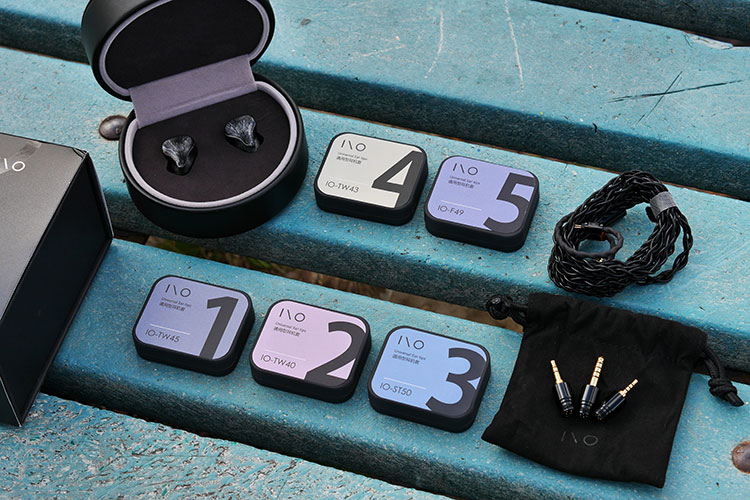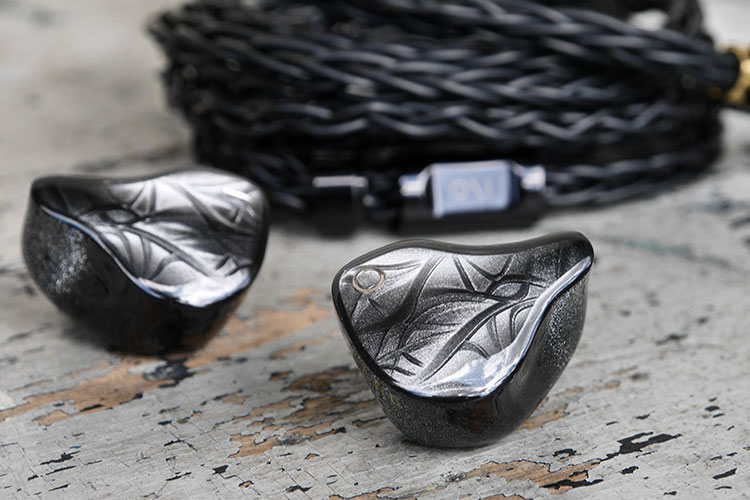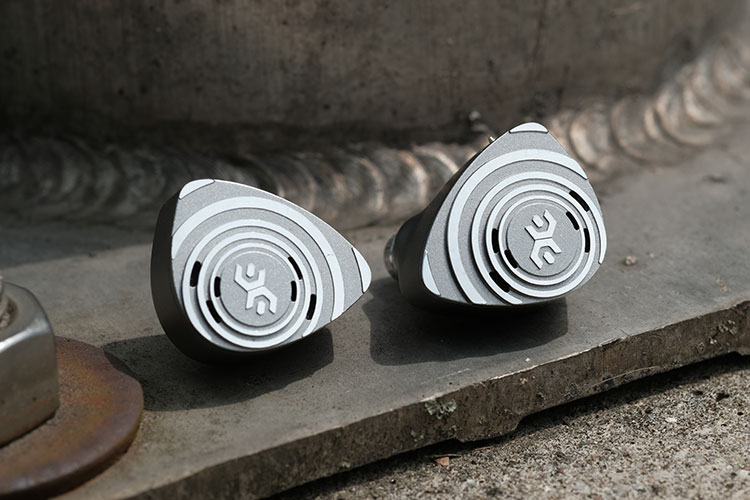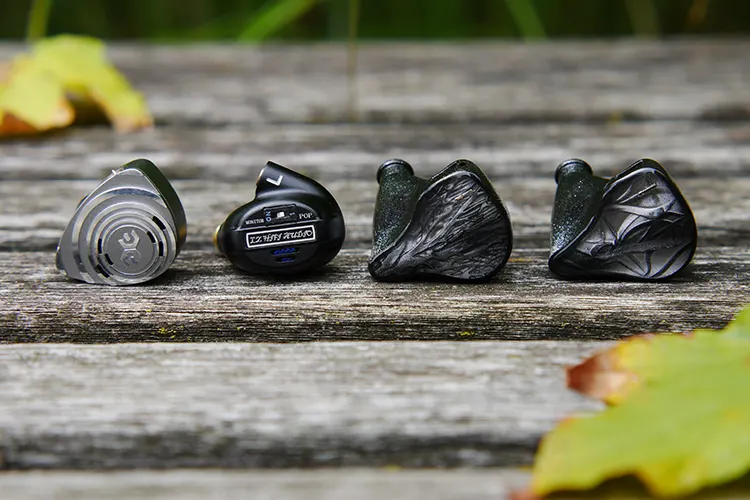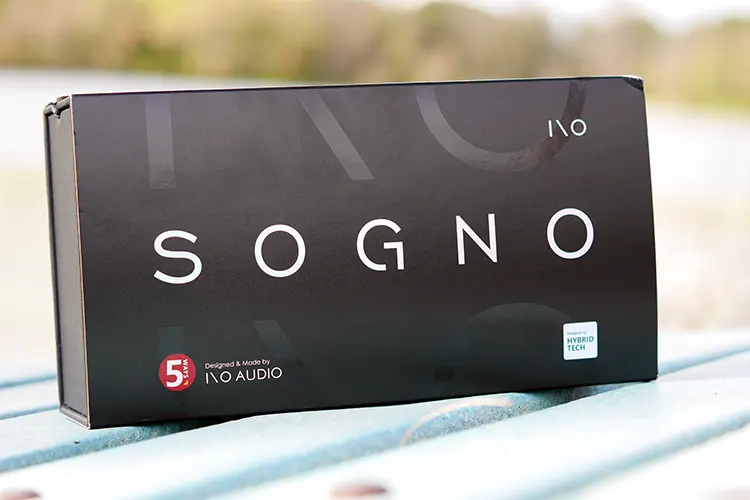Select Comparisons
I/O AUDIO VOLARE
Technical
The SOGNO is a hybrid with a dual-dynamic, six-armature configuration. The VOLARE is a tri-brid with four ESTs, quad-armatures, and a single dynamic driver.
Both models feature twin crossover designs. The VOLARE has a four-way electronic crossover with a three-way physical crossover compared to the SOGNO’s five-way electronic crossover and four-way physical crossover.
Both have HeyGears 3D-printed shells. Their designs are nearly identical save for unique faceplate designs and the SOGNO’s additional thickness and improved vent location.
Both models use the same 0.78mm 2-pin connector system and come with similar modular cables.
The SOGNO is the easier model to bring up to volume. The VOLARE has a sensitivity of 121dB compared to the SOGNO’s 126.5dB while the VOLARE’s impedance is 4.8Ω to the SOGNO’s 12.8Ω.
Design
These two models follow the same design philosophy and as a result, look very similar. They share the same ergonomic shape with smooth curves and moderate bumps on the inner side that help lock the earphone into your outer ear.
The VOLARE has a lower profile and sticks out of the ear less, but the difference is minimal. Otherwise, their ergonomics are nearly identical.
The shell materials are the same with both models featuring the same speckled metallic flakes throughout, the model’s name in gold writing, and the same nozzle design.
They have unique faceplate designs though, with the VOLARE’s being simpler and more abstract compared to the SOGNO’s leafless tree.
Isolation performance is the same too. I didn’t notice any significant difference in their ability to block outside noise when using the same tips, with both models performing quite well.
The SOGNO has one design advantage, and that is the location of the vent. On the VOLARE, it is set in front of the cable port and catches the wind, while on the SOGNO it is placed behind the cable port and is much more resistant to wind noise.
Performance
The low-end presentation is very similar on the two models with each extending well and having a decent balance of mid- and sub-bass emphasis.
The VOLARE’s driver is more rumbly and visceral, while the SOGNO’s driver is quicker and better controlled with improved texture, something I found lacking in the VOLARE’s bass presentation.
The midrange of the SOGNO has a stronger 3k peak which gives vocals more presence and gives it a more aggressive attack on percussive instruments, but also adds a level of edginess and fatigue the VOLARE does not present.
The VOLARE’s mids are warmer and more natural while retaining the same impressive levels of detail and texturing the SOGNO can output.
With the VOLARE, I/O AUDIO managed to find the perfect level of emphasis and brilliance/presence region balance. It is bright and sparkly without being aggressive and fatiguing, and the quad ESTs are remarkably smooth and refined.
While the SOGNO’s performance is excellent, the armatures used are not as smooth and refined as the VOLARE’s ESTs. They also lack the same 11k peak heard in the VOLARE, and as such the SOGNO is missing sparkle and shimmer in the brilliance region.
Staging on both is magnificent though, with each offering a wide, deep stage that allows plenty of dynamic movement. This means that both offer accurate and smooth imaging along with excellent layering and instrument separation qualities.
For most users, the SOGNO’s performance will be more than enough, but I found the VOLARE’s extra refinement and upper-end tuning balance and refinement to make it the superior earphone, even if it lacks the SOGNO’s low-end texture.
Elysian Acoustic Labs Pilgrim
Technical
The I/O AUDIO SOGNO and Elysian Acoustic Labs Pilgrim are hybrid earphones. The SOGNO features a dual-dynamic, six-armature configuration while the Pilgrim features one dynamic and three armatures.
Both models utilize electronic crossovers. The Pilgrim’s is a three-way electronic crossover, while the SOGNO’s five-way electronic crossover is accompanied by an additional four-way physical crossover.
The housing materials of the two models are entirely different. The Pilgrim is aluminum with stainless steel nozzles and a 3D-printed internal cavity to house the drivers, while the SOGNO is entirely 3D-printed resin.
Where the SOGNO uses common 0.78mm 2-pin connectors, the Pilgrim uses more durable and reliable, but less common Pentaconn connectors.
The SOGNO is easier to bring up to volume than the Pilgrim. It has a sensitivity of 126.5 dB vs. the Pilgrim’s 101 dB. The impedance of the SOGNO is 12.8Ω to the Pilgrim’s 9Ω.
Design
Both models are ergonomic in their design, with the SOGNO having a more curvaceous, form-fitting shell design that is more secure. The SOGNO is quite a bit larger though, making the Pilgrim the better option for those with small ears.
Despite the larger size and increased driver count, the SOGNO is quite a bit lighter (5.9g vs. 7.6g). The acrylic resin of I/O AUDIO’s product may lack the durability of the Pilgrim’s aluminum shells, but it does give it a notable weight advantage.
The lightness and ergonomic advantages of the SOGNO make it the more comfortable earphone to wear over long periods. The Pilgrim is fine, but the fit isn’t as secure requiring considerably more re-seats to regain a good seal when compared to the SOGNO.
Visually, both are quite stunning, though I prefer the SOGNO. The Pilgrim’s vibrant matte and glossy silver housings draw more attention, but the SOGNO’s design is more detailed and interesting when you start looking at the finer details.
Isolation is also better on the SOGNO thanks to the larger, ear-filling design, more conservative ventilation, and deeper insertion. The Pilgrim exceeded my expectations though and doesn’t fall far behind, despite the ample number of vents that adorn the faceplate.
Performance
The SOGNO’s fiber-domed 10mm dynamic provided a snappier bass experience than the Pilgrim’s 9.2mm driver, with slightly improved texturing and a quicker attack/decay cycle. The differences are minimal though and I found the Pilgrim’s presentation more engaging thanks to improved feedback on deep, visceral notes.
The SOGNO’s upper-mid push brings the vocals more forward than they are out of the Pilgrim. The presentation is cooler and drier out of the SOGNO though, and it sounds more natural with male vocals while the Pilgrim worked better with female vocalists.
Despite the SOGNO’s stronger upper mids, it better handled sibilant tracks. The Pilgrim’s presentation is leaner and harsh tees and esses were more aggressive and fatiguing.
Heading into the upper ranges, the SOGNO focuses on the presence region while the Pilgrim biases the brilliance region. As a result, the Pilgrim’s upper ranges match their exterior design, with plenty of sparkle and shimmer, qualities that are present in the SOGNO, but more reserved.
Detail and clarity are excellent on both, with the Pilgrim’s leaner presentation giving it a small edge. The thinness helps individual notes stand out more, and aids in the upper ranges having a more spacious, airy feel.
Despite this, I found the SOGNO to be the more technical of the two. The staging was more dynamic, offering a greater impression of depth and width, despite a default vocal positioning closer to the ear.
This impression was echoed in imaging qualities. Sounds moved from channel to channel with more precision on the SOGNO, though their off-center performance was equally impressive.
The SOGNO’s staging improvements carried over to track layering and instrument separation which were clearer than on the Pilgrim. It was easier to pick out individual instruments and track them, even if they didn’t sound as detailed as through the Pilgrim.
LZ A7
Technical
The SOGNO is a hybrid earphone with a dual-dynamic, six-armature configuration. The A7 is a tri-brid with a single dynamic, quad-armatures, and two 7-layer piezoelectric ceramic drivers.
Both models utilize electronic crossovers. The A7’s is a four-way electronic crossover, while the SOGNO’s five-way electronic crossover is accompanied by an additional four-way physical crossover.
The A7 has aluminum housings with a shape reminiscent of the venerable Shure SE846. The SOGNO’s shells are 3D-printed resin with a more ergonomic, form-fitting shape.
The A7 features an extensive tuning system with a balanced MONITOR mode, and a more V-shaped POP mode, both of which can be customized further via five included interchangeable nozzles. Several aftermarket nozzles also fit, giving users even more customizability, none of which exists for the SOGNO.
Both models use common connectors, MMCX for the A7 and 0.78mm 2-pin for the SOGNO. I find the simpler 2-pin systems to be more reliable long-term while having equally as plentiful third-party cable options available.
The SOGNO is easier to bring up to volume than the A7. It has a sensitivity of 126.5dB vs. the A7’s 109 dB in POP mode and 113 dB in MONITOR mode. The impedance of the SOGNO is 12.8Ω to the A7’s 15Ω in POP mode and 13Ω in MONITOR mode.
Design
The two models take different approaches to their design with the SOGNO following the current trend of having a curvaceous, ergonomic shell that locks into the outer ear. The A7 heads back in time and takes inspiration from Shure’s legendary SE846’s ovular, jellybean-shaped shells.
Both models are very comfortable with great ergonomics. The A7 is heavier than the SOGNO (7.1g vs. 5.9g) but the smaller size and featureless shell allow it to nearly disappear when worn, though it lacks the stability of the SOGNO and needs re-seating more often.
Both models are interesting to look at, the SOGNO in a more creative, modern way, and the A7 in a more technical, classic hi-fi way. The SOGNO’s faceplates are a visual treat with their tree-inspired design, while the A7’s faceplates are dominated by functional details.
The face of the A7 contains colored vents that denote the channel along with L and R markings on the MMCX stem, a tuning switch, and the brand name. It looks functional, purposeful, and in my opinion, interesting, just not very attractive, especially when sat next to the SOGNO.
Isolation is firmly in the SOGNO’s favor thanks to the ear-filling size and deeper insertion. The A7’s ability to passively isolate is quite average, requiring a volume increase in situations where the SOGNO requires none, though it better resists wind buffeting.
Performance
The A7 was tested in POP mode with the gold filter. This setup gives the A7 a mild V-shaped signature and increases the presence of the low end to better match the SOGNO.
The SOGNO’s low-end performance is a notable step up from the A7. Visceral feedback is much more prominent from the newcomer, with deep notes providing a layer of rumble mostly lacking from the A7.
The A7’s bass presentation is considerably more linear though, with a greater balance of mid-and sub-bass emphasis. Both offer great texturing with good control with the A7 being a touch slower on both attack and decay.
Heading into the mids, the A7 is better balanced with the bass and treble presentation, while being a hint warmer, leaner, and more versatile across various vocalists. The SOGNO’s midrange is more natural sounding though, with better clarity and detail.
The A7’s piezoelectric tweeters have a leaner presentation than the 6mm/dual-armature combination that handles the SONGO’s high ranges.
Extension from both configurations is excellent with a similar presence/brilliance region balance, meaning both offer some sparkle and shimmer, but not a lot, while instead focusing more on pumping out the detail and clarity.
Staging is where the SOGNO pulls far ahead. The A7’s staging is considerably smaller in every dimension with the default vocal positioning being firmly inside the ear, giving it a congested presentation compared to the SOGNO.
This unfortunately carries over to layering and instrument separation qualities which while perfectly competent on the A7, lack the depth and dynamics heard from the SOGNO. The overall presentation is flatter and less immersive.
The A7 images quite well though, with accurate and smooth channel-to-channel transitions that almost keep up with the SOGNO. While still a good performer overall, the A7’s age is showing.
My Verdict
I had high hopes for the SOGNO given how good the VOLARE was, and it did not disappoint.
The eight-driver hybrid setup is well-tuned with great bass performance, outstanding clarity, and a large, dynamic soundstage. The upper mid-peak can be a touch aggressive at times and I’d like a bit more brilliance region energy, but those are the only qualms I have in what is otherwise a very well-tuned earphone.
From a design and build perspective, the SOGNO is again fantastic. The shells are flawlessly printed, the faceplate design looks amazing, the ergonomics are excellent, and its passive isolation and wind resistance are also quite good.
The cable is a bit of a letdown. While the 2-pin system is more secure this time, I had issues with the modular plugs and the collar design is still annoying to work with given it constantly gets caught in the various cable strands.
It’s not a bad cable by any means, just one that needs to be further refined so that the user experience is better.
Thankfully the rest of the accessory kit more than makes up for the cable. The extensive tip selection and the plastic cases each style comes in are awesome, and the carrying case, while not convenient to use, certainly looks and feels like a premium addition that wouldn’t be out of place paired with something costing significantly more.
Like the VOLARE before it, I think the I/O AUDIO SOGNO is a top pick in its price range. I have no issues recommending it to anyone looking for an energetic, technically capable earphone that looks as good and wears as well as it sounds.
I/O AUDIO SOGNO Technical Specifications
- Frequency Response: 10Hz–30kHz
- SPL: 126 dB/Vrms @ 1 kHz
- Impedance: 12.8Ω @ 1 kHz
- THD: <0.8% @ 1kHz




